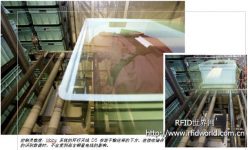
Safe identification and quality assurance-RFID system used in automobile production
[ad_1]
With the increasing degree of product customization (this is very common in today’s automotive industry), how to effectively divide labor has become a challenge. Therefore, thousands of components and work steps have to be adjusted, recombined and sequenced again and again, and finally, the customized car can be delivered. In this process, the non-contact operation of the fully automatic identification system plays a key role. The cases listed here just prove this truthfully. The protagonist of our case is a famous Bavarian automobile manufacturer.

“Timely and orderly” supply is a magic word in modern automobile production, and its meaning is to deliver the appropriate components to the appropriate place at the appropriate time to prepare for the proper installation of the body parts. This shows that logistics in the production process has become more and more important. From an internal perspective, this requirement can be met by introducing a control system of an appropriate scale. But if raw materials, modules or all assembly units need to be provided by external suppliers, an independent on-site solution is required. Therefore, each component must be accurately identified, so that it can not only meet the requirements of the end customer, but also track the record of quality data.
BMW’s 1.1 plant in Munich mainly produces three new series of cars and station wagons. Since BMW is 100% customized production on demand, and many equipment options are related to complex electronics, not only the wiring harness has become the lifeline of the car, but the correct distribution has also become the determinant of production efficiency.
No mistakes can be made during assembly, and errors in the wiring harness will inevitably scrap the entire vehicle. “Therefore, every wire harness must be clearly and accurately determined during delivery, storage, evacuation from storage and distribution to the assembly process. This is very important to us.” Control system engineer Carsten Ranker emphasized. All this information is sent to the central computer from the RFID system Moby D (sensor product series launched by Siemens Automation and Drives (A&D)), and these systems are installed on the wiring harness storage and feeding equipment of the equipment.
4 stations, 1 target: continuous control
The individually bagged wire harnesses are delivered in a shipping container. Inside the bag is the mobile data storage unit MDS D100. The EEPROM (112 bytes) of this unit receives the necessary data and is used to effectively identify the wire harness on the feeding device.
The data storage unit is only the size of a credit card, and it is inserted into a safe cover to prevent it from being damaged in the daily harsh industrial environment.
At the time of delivery, the transport container needs to be separately loaded into the rack feeder where the wire harness is stored. During the production process, they will pass the reader SLG D10 with D5 antenna, which is installed under the conveyor belt. The antenna generates an interactive induction magnetic field to supply power to the passive components of the data storage unit and send data. BMW’s wiring harness has a special number, which is the exclusive number for the ordered vehicle.
Based on this information, the shipping container is stored in the designated location. If the corresponding car body is transported from the overhead storage facility to the start of the assembly line, the central computer will query the corresponding wiring harness through the order number. Then, it will retrieve the data from the storage, and after reconfirming by the conversion station, it will be distributed to the assembly process. Before inserting the body, another station will confirm the data again. The data will then be deleted to prevent it from being confused with subsequent data.
The current order number can be viewed through the Simatic HMI operation panel, which displays the data of the main storage/conversion station and the auxiliary storage/conversion station at the same time. In the auxiliary station, if the wiring harness cannot be confirmed, the hand-held reader STG D can be used for manual detection and distribution.
Parallel operation without failure
Moby D is not the first Siemens RFID system used by BWM in Munich’s wiring harness storage. Before the introduction of the new 3 series, the original Moby L system was used to identify the wiring harness. During the 6-month transition period, Moby L was still used, working in parallel with the new system. Therefore, the current antenna is integrated into the larger loop antenna D5, and the two systems do not interfere with each other.
During the transition period, the construction of the newly introduced system, Profibus and power equipment were all completed independently, so the installation of the Moby L system that was later configured did not have any impact on the current production. In terms of control system, it is also very convenient. The configured Simatic S7-400 can be expanded with only a Profibus plug-in module. For BMW control system planners, the advantages of using Siemens automation technology are very obvious: “BMW has a very high degree of integration and standardization. Each workstation, the operator can use the same control screen, which can reduce training and reduce errors. At the same time, improve the efficiency of spare parts inventory.”
In addition, Siemens’ good technical support is also one of the reasons that contributed to the automaker’s decision to adopt the Moby system. At first, the RFID solution was not the best solution for copper-containing wiring harnesses, because metal would weaken the magnetic field strength of the interactive magnetic field generated by the antenna, which would reduce the reading distance of the data storage unit. After a large number of magnetic field tests, Siemens experts decided to use this task optimization solution, which is also an equipment cost optimization solution. In the conveyor belt system itself, the two metal rollers in the antenna had to be replaced with plastic rollers, and the metal shafts of the plastic rollers were relatively thin.
RFID technology is reliable and has great development potential
Therefore, BMW now has a reliable system with sufficient reading distance. For example, its MDS can be arbitrarily positioned in the shipping container without reading errors. When asked about the experience of using Moby D in the wiring harness storage, Carsten Ranker replied, “We handed over the Siemens components to our equipment engineers, and they successfully completed the installation and configuration.
Since the trial operation, the system has been operating normally, which has also ensured the smooth installation of the wiring harness. In addition to Simatic Moby D, BMW’s 1.1 plant (from body assembly to vehicle positioning in the workshop) also introduced Moby E, I, R and U systems. Feedback from the Munich plant is good. Therefore, BMW plans to In the future, Regensburg, Dingolfing and Leipzig will also use the Moby D system for wire harness identification.

[ad_2]




